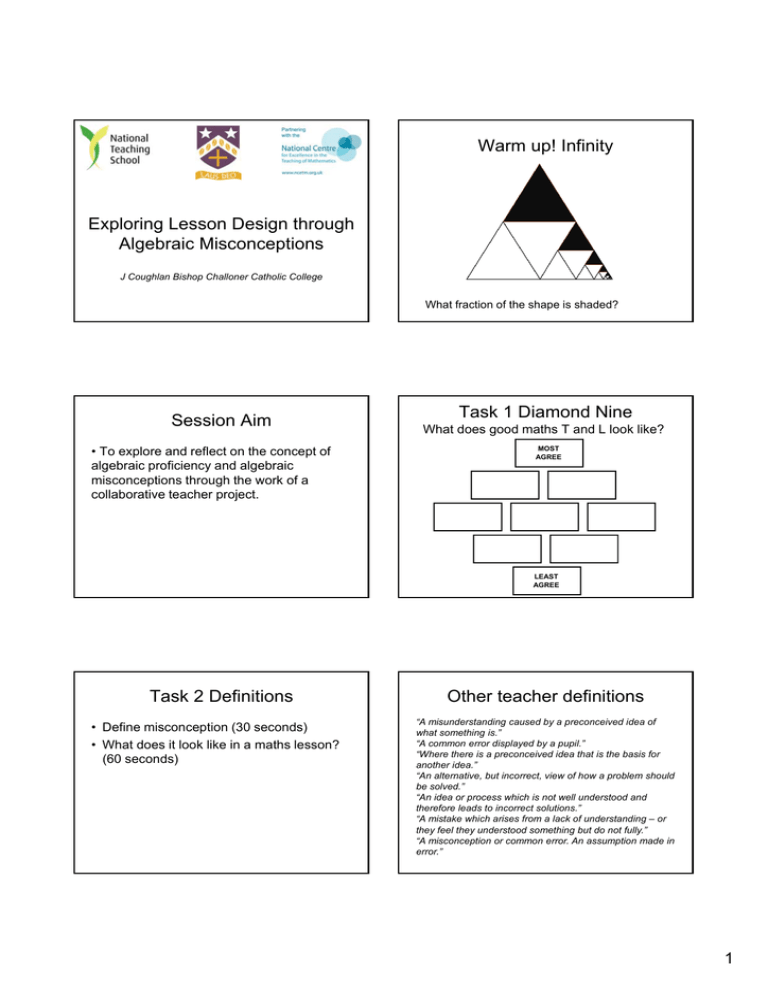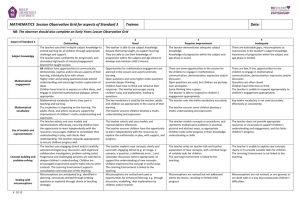Warm up! Infinity Exploring Lesson Design through Algebraic Misconceptions Task 1 Diamond Nine
advertisement

Warm up! Infinity Exploring Lesson Design through Algebraic Misconceptions J Coughlan Bishop Challoner Catholic College What fraction of the shape is shaded? Session Aim • To explore and reflect on the concept of algebraic proficiency and algebraic misconceptions through the work of a collaborative teacher project. Task 1 Diamond Nine What does good maths T and L look like? MOST AGREE LEAST AGREE Task 2 Definitions • Define misconception (30 seconds) • What does it look like in a maths lesson? (60 seconds) Other teacher definitions “A misunderstanding caused by a preconceived idea of what something is.” “A common error displayed by a pupil.” “Where there is a preconceived idea that is the basis for another idea.” “An alternative, but incorrect, view of how a problem should be solved.” “An idea or process which is not well understood and therefore leads to incorrect solutions.” “A mistake which arises from a lack of understanding – or they feel they understood something but do not fully.” “A misconception or common error. An assumption made in error.” 1 Task 3 Misunderstanding Misconceptions vrs Misunderstandings • “Mistakes through errors, through lapses in concentration, hasty reasoning, memory overload or failing to notice the important features of a problem. In these cases they often recognise their 'mistake' and it doesn't necessarily hinder their progress in learning mathematics.” • Sort the cards into those you think are misconceptions and those you think are misunderstandings. • Include your own examples in the discussion. • There is a A-level set and a GCSE set. Misconception Our Project • “Sometimes, however, the mistake is due to a misconception a learner has about a topic. In this case the mistake is the result of a consistent, alternative interpretation of a mathematical idea. Here there is something that has not been clearly understood about the mathematics being learnt.” • 3 schools working together with triads from each school. • Four distinct phases to the project with clear gap tasks. • Sep to March The Mathematical Agenda… • Focus on Mathematical Proficiency • arithmetic, algebraic and geometric • Aim is that pupils are able carry out mathematical procedures flexibly, accurately, consistently, efficiently and appropriately • Procedures and understanding are developed in tandem ???Algebraic Proficiency is the appreciation of the process of generality in the context of number, and the ability to build connections between representations of generality (graphs, tables of numbers, algebra) and manipulate algebraic symbols efficiently, fluently and accurately. 2 Typical Lesson design Activities Questioning Alternative Lesson design Misconceptions Arise Objectives Activities Questioning Misconceptions Reflection LEARNING TAKES PLACE Objectives Reflection ENSURE LEARNING TAKES PLACE Resources to support The five resources showcased were • Effective questioning • Multiple representations • Multiple right • Sometimes, always, never true • Dynamic maths Observations Feedback and Dissemination • Focusing on the maths and the way it is being taught rather than specifics e.g. behaviour (unless learning related) and structure of the lesson per se. • Pay particular attention to the misconceptions being addressed in the lesson. • Make judgements about the progress of students as a result of the design of the lesson. • Evaluate the usefulness of the resources used. • Look out for use of effective questions and multiple representations. 3 Multiple Representations ( x 5)( x 2) x 2 10 • Multiple representations used to convince in a range of different ways. • How convincing can you make the argument is the key and can you do this in several ways? ( x 5)( x 2) x 10 2 An odd number multiplied by an even number is always even! What kind of numbers are both sides of the above identity? Why can this statement not be true in general? ( x 5)( x 2) x 2 10 y ( x 5)( x 2) y x 2 10 x 3 2 x2 9 Dynamic Mathematics 4 Collaborative projects • Funded through NCETM (up to £5,000) • Must focus on either algebraic or arithmetic proficiency. • Must now involve a school for which mathematics is a key priority. • Needs the support of an improvement partner. Key Outcomes from the project • Is a misconception still a misconception if context matters? • Multiple right resources were well liked. • Misconceptions and misunderstandings can be hard to distinguish. • Students were given the freedom to use methods that worked for them as long as they made sense mathematically. More outcomes • No fear of mistakes. • Good discussion of alternate methods. • Emphasis on method and conceptual understanding over answer getting. • High quality questioning to draw out understanding. • Lots of independent learning taking place and excellent levels of mathematical communication evident between pupils. 5 Resources for Keele FMSP Session Good maths teaching happens when… students learn new material and then progress to harder and harder material during the course of a lesson/series of lessons. Good maths teaching happens when… students learn through solving problems, investigating and applying their skills to reallife tasks. Good maths teaching happens when … students work independently and develop their own understanding of new topics with support from the teacher. Good maths teaching happens when… key ideas within the mathematics curriculum are linked and students begin to see the bigger picture. Good maths teaching happens when… students build their understanding of a concept through a variety of different approaches. Good maths teaching happens when… students learn a new skill and are given time to practice this. Good maths teaching happens when… the teacher builds on the students’ prior learning to introduce new concepts. Good maths teaching happens when… students make mistakes and are given the opportunity to reflect on, and learn from, them. Good maths teaching happens when… students show they have become efficient and proficient in all aspects of the mathematics curriculum 3 2 is 6 x 2x 3 2x 3 2 x 4x 5 4x 5 2 5(2 x 1) 3( x 4) is the same as 10 x 5 3 x 12 ( x y) x y 2 2 2 2 2 2 3 4 12 x x for all x 2 x 10 x 2 5 ab a b 3 3 0 9 is a prime number 1 1 1 x x 2x 2 y (3 y 4) 6 y 8 2 2 d y 0 2 log a log b log( a b) dx relates to a max point arccos x sec x stretched by scale factor 2 sin 2 x is sinx x 1 A B 2 ( x 2)( x 3) ( x 2) ( x 3) 2 d 2 log(2 x) dx x (a x) a (1 x) n 2 n x dx x 2 0 2 2 0 n If x 2 is a solution of f ( x) 0 then x 2 is a factor y x 1 is y x 2 x dx 0 1 2 1 translated by vector 0 x 1 x 1


